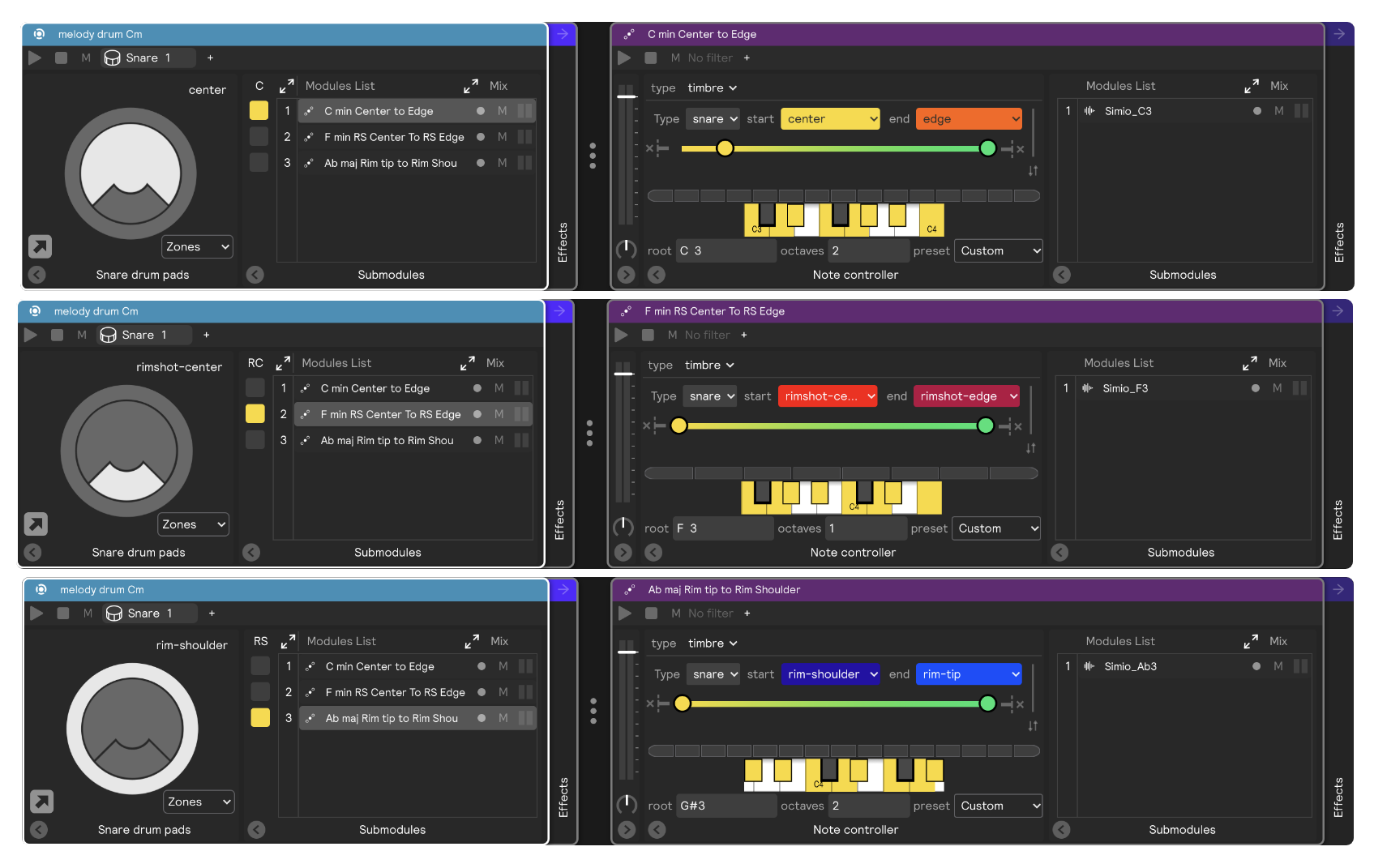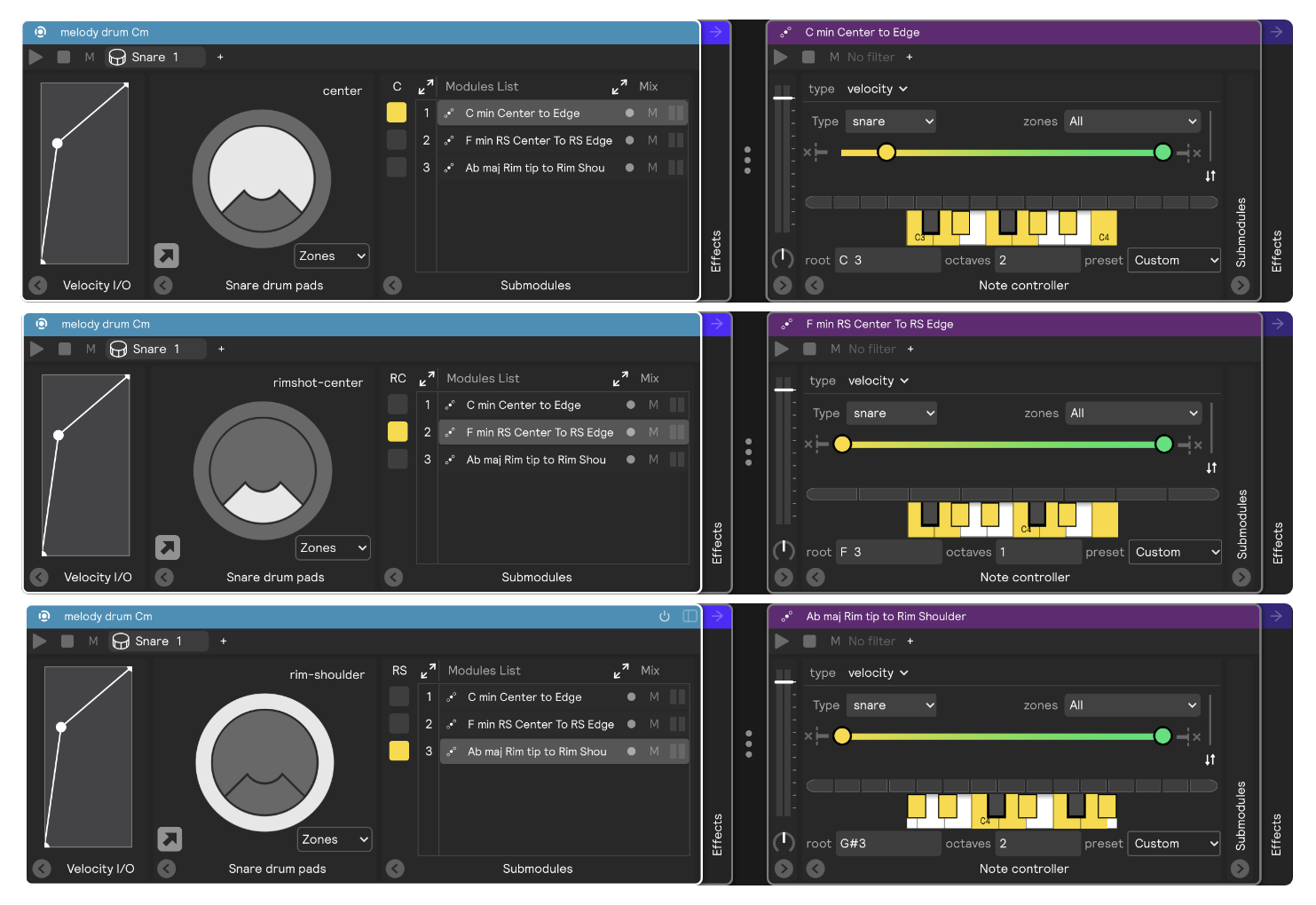How to Use Melody and Harmony
It's a given that the depth of electronic control enabled by Sensory Percussion was bound to revolutionize the way drummers approach tonality.
The added dimensions of timbre control, along with velocity, speed, and LFOs allows for rich melodic and harmonic structures never before possible on the drum set. And with the modular framework of Sensory Percussion V2, building advanced tonal structure into your Sensory compositions is now more manageable than ever before.
Tonality on the drums is a completely new phenomenon and there are very few established standards for how to build tonal drums, but below are some tips and/or starting points for your designs.
The tools you will use when designing tonal drums
In Sensory Percussion the tools you have on hand to build tonality into your sets are your drum's natural playability, which is encapsulated in the Sensory Percussion's assignments & modulators and controllers.
And the cornerstone for many Sensory Percussion tonal adventures is the note controller, which sends note messages to modules contained within.

In the sections below we will explore different note controller schemas, and how you might design them to interact with other controllers. And we will also go over other methods of creating tonal drums that don't hinge upon the note controller, relying instead on the sequencer controller and the sampler's transpose parameter.
Building a Logical and Easily Playable Timbrally Sensitive Tonal Drum
Before we get into controlling melody with timbre, let's define what the word "timbre" means in Sensory Percussion terms. If you think about timbre change from the center to the edge of the drum, you might think timbre simply refers to where you hit the drum, but that doesn't quite cover it. Timbre in general refers to the quality of a musical sound as distinct from its pitch or volume (it's the difference between a trombone and a saxophone playing the same note at the same volume).
There are many ways to get different timbres out of an acoustic drum other than hitting different parts of the head. You could hit the same location of the rim with the shoulder of your stick, and then with the tip of your stick, and you would get two different timbres. So it's more about HOW you're hitting the drum, not just WHERE you're hitting it. The ability to recognize these timbral differences and translate them into parameter control is part of what sets Sensory Percussion apart from traditional drum triggers.
The primary timbral ranges of a snare or tom drum are: Center-to-Edge, Rimshot Center-to-Rimshot Edge, and Rim Shoulder-to-Rim Tip. Yes, there are many other ranges to be explored, but the aforementioned ranges paint a very detailed timbral picture of the drum and will provide your tonal drum a good amount of timbral sensitivity even to the other zones, since each unused zone has a relationship to one or more in the range (for example: Damped is closely related to Center and Edge).

In the screenshots above you can see there is a drum map with Center, Rimshot Center, and Rim Shoulder as active zones. Each of the active zones has a note controller with the notes of the C natural minor scale.
The Center-to-Edge range starts on C and ranges two octaves, and is extra sensitive to the tonic (take a look at sensitivity slider, and the bottom step which is expanded larger than the other steps). This is so it's easier to hit the tonic (C) by hitting close to the center of the drum. The other two octaves of the C minor scale are expanded out towards the edge of the drum head.
In the second screenshot you can see that the Rimshot Center-to-Rimshot Edge note controller contains one octave of the F melodic minor scale (or the C natural minor scale, but starting on F). And in the third screenshot you can see that the Rim Shoulder-to-Rim Tip ranged note controller contains an Ab Major scale (or the C Phrygian scale starting on Ab).
So here we have a C minor drum that responds naturally and predictably to your playing: hitting the center of the drum will play the tonic, and the C minor scale rings out as you play the drum out to the edge. Striking rimshots from the center to the edge will release the same scale, but centered around the 4th (or F). And playing the rim from the shoulder of your stick to the tip of the stick will sound an Ab Major scale (or C Phrygian starting on Ab).
We will return to and expand upon this timbre mapping in the "Building A Four Voice Harmony Drum" and "Tips for Moving Through Tonal Structure" sections of this article.
Using Velocity or Speed Instead of Timbre to Control Scales
You can substitute velocity or speed instead of timbre if that strikes your fancy. Simply select "velocity" or "speed" from the "type" dropdown of the Note Controller.
Velocity

If you have selected "velocity," you can try engaging the "flip" parameter of the note controller. Sometimes it feels best to hit the low notes with quiet strokes, but other times it feels good engage the low notes when you hit hard.
It also is worth testing a velocity I/O curve setting like the one in the screenshots above in order to remove some velocity playback sensitivity and have only the pitches change with your hard/soft playing, but not the volume of the samplers.
Speed

If you have selected "speed" for the type of note controller, try setting a high sensitivity like in the screenshots above: especially for zones on the head or rims, where you can play faster rolls. For Rimshot speed controllers, you can try a lower sensitivity.
Using the Sequencer to Employ Arpeggios
The basic version
The sequencer controller allows you to arpeggiate pitched samplers to create interesting melodies!

Above, the Cataratas harp sampler has been duplicated four times, with each sampler repitched using the "transpose" sampler feature to a different partial of a C Major triad. Steps were added to the sequencer and a nice, eight-step rhythmic pattern composed.
Static chord version

You can experiment by removing all but one of the steps and assigning all of the repitched samplers to that one step, functionally turning this sequencer into a group controller.
Chord with movement version

Or you can create a denser sequence, like above, to retain the chordal nature of the drum, but give it a bit of arpeggiated movement with repeated hits to the sequencer.
Note Controller as an Octaver

You can drag one of your sequenced melodic creations into a Note Controller: or even right-click on it to Group Into a note controller
Select the bottom and top keys of the keyboard to turn the note controller into an octaver. You can see in the screenshot above that the note controller's input type is "timbre" with a range of center-to-edge. You can also see that the number of octaves is set to "2." So this means that the arpeggiated sequence contained within will now be octaved over a two-octave range by playing center from center to edge.
Check back later for more! This page will be updated as new and interesting tonal Sensory techniques are developed.